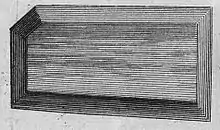
Drawing of the Great Table diamond, by Tavernier in 1676
The Great Table was a large pink diamond that had been studded in the throne of the Mughal emperor Shah Jahan. It has been described in the book of the French jeweller Jean-Baptiste Tavernier in 1642, who gave it its name ("Diamanta Grande Table").
The diamond was plundered by Nader Shah during his invasion of India in 1739 and disappeared after his assassination.
In 1965, a Canadian team from the Royal Ontario Museum conducting research on the Iranian Crown Jewels concluded that the larger Daria-i-Noor and the smaller Noor-ul-Ain 60 carats (12 g) may well have been part of the Great Table.[1]
See also
References
- ↑ Great Table Diamond, gem, Britannica.com
- A. Malecka, "The Mystery of the Nur al-Ayn Diamond", Gems & Jewellery: The Gemmological Association of Great Britain, volume 23 (7), August/September 2014, pp. 20-22 https://issuu.com/jeweller/docs/jeweller_g_j__sept_2014_/58
- A. Malecka, "Darya-ye Nur: History and Myth of a Crown Jewel of Iran", Iranian Studies vol. 51 (2018), https://dx.doi.org/10.1080/00210862.2017.1362952
External links
- Great Table Archived 8 October 2017 at the Wayback Machine, By Scott Sucher, Museum Diamonds
This article is issued from Wikipedia. The text is licensed under Creative Commons - Attribution - Sharealike. Additional terms may apply for the media files.